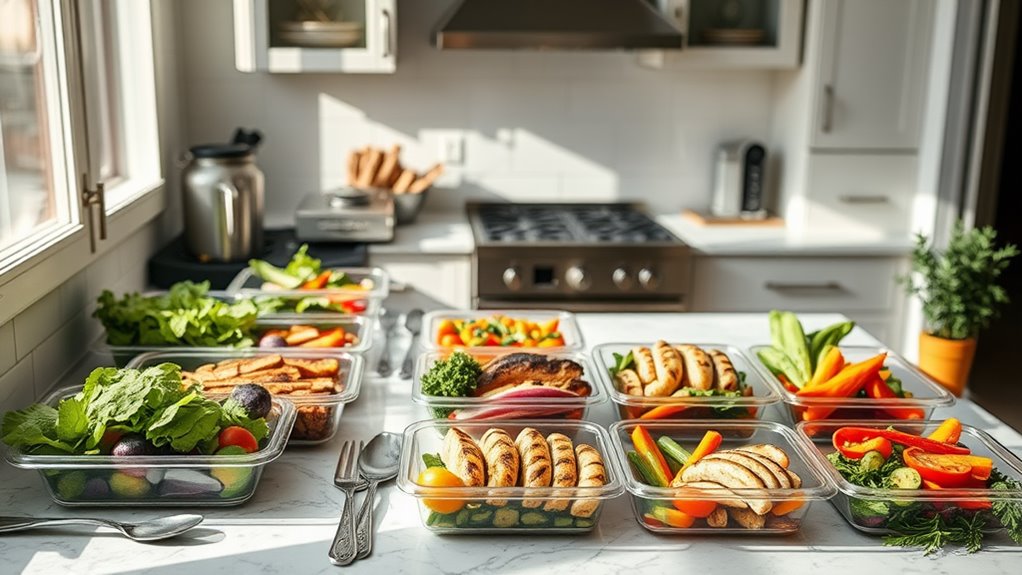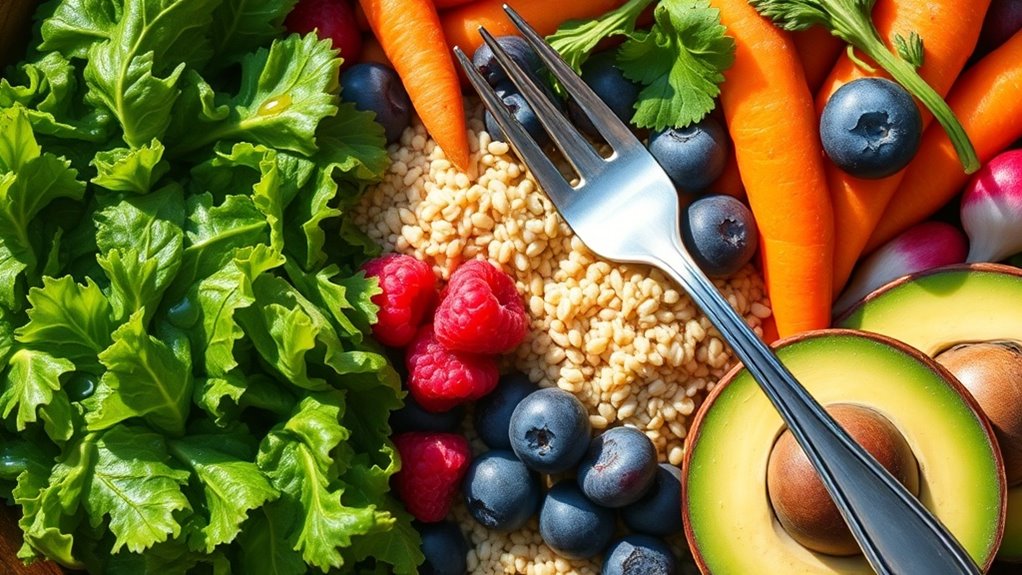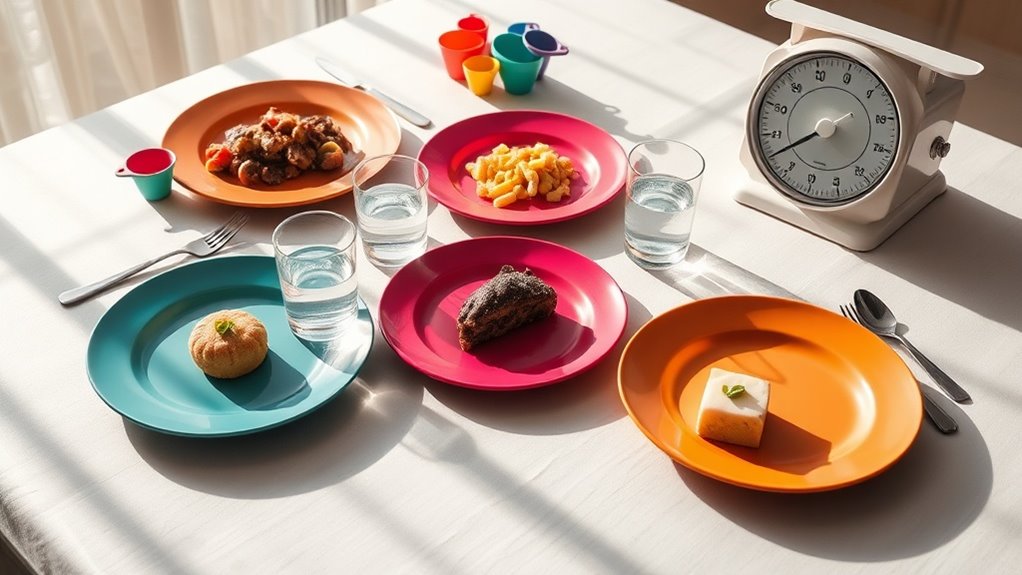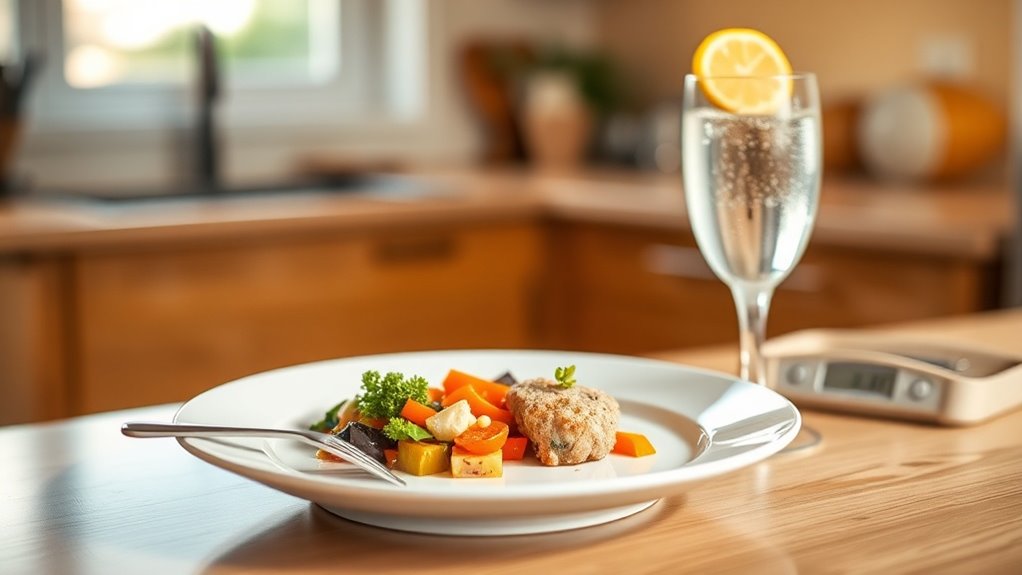How to Master Meal Prep for Weight Loss Success-Without the Stress!
Just as you’re starting your weight loss journey, meal prep coincidentally aligns with your daily routine in ways you might not expect. Plan your meals strategically to hit calorie goals without overwhelm, using balanced, nutrient-rich options for lasting results. You’ll soon uncover techniques that keep it simple and effective.
Key Takeaways
- Plan meals weekly by calculating calorie needs and batch-cooking to create a stress-free routine.
- Shop efficiently by categorizing whole foods and checking recipes to avoid impulse buys.
- Use simple cooking methods like one-pot meals to streamline prep and ensure balanced portions.
- Store prepped meals in labeled, airtight containers to maintain freshness and reduce waste.
- Track progress weekly and adjust recipes based on your body’s response for sustained motivation.
Plan Your Meals Strategically
How can you plan your meals strategically to support weight loss?
Effective meal prep starts with calculating your daily calorie needs and focusing on nutrient-dense foods.
You’ll choose balanced recipes that prioritize vegetables, lean proteins, and whole grains to create a sustainable calorie deficit.
By prepping meals in advance, such as batch-cooking on weekends, you control portions and avoid last-minute temptations.
Research shows this approach boosts adherence to healthy eating patterns, reducing overeating.
Make meal prep a routine: set weekly goals, measure ingredients precisely, and store portions for easy access, ensuring consistent progress toward your weight loss targets.
Additionally, incorporate portion control techniques by filling half your plate with vegetables to maximize volume without adding extra calories.
Build an Efficient Grocery List
After planning your meals, you’ll build an efficient grocery list that supports your weight loss strategy by focusing on essential ingredients.
Start by categorizing items into groups like produce, proteins, and staples to minimize aisle wandering.
Research indicates that emphasizing whole foods—such as leafy greens, lean meats, and whole grains—boosts nutrient intake while cutting empty calories.
Stick to your plan by checking quantities against recipes, avoiding impulse buys that derail progress.
Use a simple template to note seasonal deals, ensuring cost-effectiveness and adherence to evidence-based nutrition guidelines for sustainable results.
To align with celebrity strategies, try shopping the perimeter for fresher, healthier options that prioritize whole foods.
Simplify Batch Cooking Techniques
Batch cooking streamlines your meal prep by letting you prepare multiple servings at once, saving time while aligning with weight loss goals.
To simplify, start with versatile techniques like one-pot methods, which cut down on dishes and streamline workflows.
You’ll use tools such as sheet pans for even roasting or slow cookers for effortless simmering, backed by studies showing they boost adherence to calorie-controlled plans.
Group tasks—chop all veggies first—to minimize interruptions, enhancing efficiency.
This practical strategy, endorsed by dietitians, ensures consistent portions and reduces daily decisions, fostering long-term success without overwhelm.
To maximize your batch cooking, incorporate sharp knives for efficient pre-chopping of vegetables and proteins, as outlined in essential meal prep tools.
Select Healthy and Balanced Recipes
Since your meal prep aims for weight loss, choose recipes that balance macronutrients like proteins, healthy fats, and fiber-rich carbs to support sustained energy.
Evidence from nutrition research shows this balance stabilizes blood sugar and reduces hunger, key for fat loss.
Opt for practical options like grilled fish with veggies and quinoa, or bean-based salads with nuts; these provide essential nutrients without excess calories.
Focus on portion control and whole foods, such as leafy greens and lean proteins, to maximize satiety.
Experiment with simple tweaks, like adding herbs, to keep meals flavorful and sustainable.
Incorporate batch cooking techniques to prepare larger portions of grains and proteins in advance, making it easier to maintain your weight loss goals while saving time.
Organize Storage for Freshness
You’ll keep your prepped meals fresh longer by organizing your storage effectively, which preserves nutrients and supports your weight loss goals.
Choose the right containers that seal airtight to prevent spoilage, label your food items with dates for easy tracking, and rotate your stock regularly to use older items first.
This strategy minimizes waste and maximizes the quality of your meals, based on proven food safety practices.
To further optimize freshness, ensure you keep vegetables in separate containers as part of efficient meal preparation techniques.
Choose Right Containers
When selecting containers for meal prep, how can you ensure your food stays fresh and organized?
Opt for airtight, BPA-free options to minimize oxidation and bacterial growth, preserving nutrients and extending shelf life—backed by food safety studies.
Choose glass for durability and odor resistance, or lightweight plastic for portability; both help maintain meal integrity.
Select various sizes to fit portions perfectly, promoting efficient storage and reducing waste.
Stackable designs maximize fridge space, making it simple to access prepped meals daily, so you stay on track with your weight loss plan effortlessly.
Label Food Items
Labeling your food items keeps your meal prep organized and fresh.
It helps you quickly identify contents, preparation dates, and storage requirements, minimizing spoilage risks.
Research from the USDA confirms that clear labeling extends shelf life and cuts food waste by up to 40%, promoting healthier eating habits for weight loss.
Use waterproof labels or apps to note specifics like ingredient lists and best-by dates on containers.
This approach ensures you access meals efficiently, maintain nutritional quality, and reduce decision fatigue, making your routine practical and effective without added hassle.
Rotate Stock Regularly
Regularly rotating your stock ensures that older items get used first, maintaining freshness and minimizing waste in your meal prep routine.
To implement this effectively, adopt the FIFO (First In, First Out) method: place newer groceries at the back of your fridge or pantry, so you’re always reaching for the oldest first.
This prevents spoilage and preserves nutrients, as studies show fresh produce loses vitamins quickly when stale.
You’ll save money—research indicates households waste up to 20% less food with rotation.
Check dates bi-weekly, reorganize storage, and integrate this into your weekly prep to support sustained weight loss effortlessly.
Incorporate Flavor and Variety
How can you keep your meal prep exciting while supporting weight loss?
Adding flavor and variety prevents monotony, which research links to better adherence and sustained calorie control.
Focus on nutrient-dense options that enhance satisfaction without excess calories.
-
Use herbs and spices liberally: They amp up taste—think turmeric for anti-inflammatory benefits—while keeping meals low-cal.
-
Incorporate colorful produce: Rotate veggies like spinach, bell peppers, and berries for vitamins and antioxidants, making meals visually appealing.
-
Mix proteins and grains: Swap chicken for fish or quinoa for rice to provide variety, ensuring balanced macros for energy and fullness.
Additionally, introducing variety in your meals can help prevent metabolic adaptation by maintaining an efficient metabolic rate.
Sustain Momentum and Adjustments
Once you’ve built a solid meal prep routine, you must keep momentum alive by tracking your progress weekly to maintain motivation and prevent burnout. This approach draws from research showing that consistent monitoring boosts long-term adherence in weight loss efforts. You’ll also make key adjustments to your plan, tweaking portions or recipes based on your body’s responses for optimal results. Additionally, to effectively break through weight loss plateaus, consider implementing caloric cycling in your routine to alternate calorie intake and prevent metabolic adaptation.
Keep Momentum Alive
As you build your meal prep habit for weight loss, it’s essential to tweak your routine regularly to sustain momentum and avoid burnout.
This keeps your efforts engaging and effective, drawing from research on habit formation.
To maintain progress without overwhelming yourself, try these evidence-based strategies:
-
Track your weekly achievements and log adjustments, as studies show this monitoring boosts consistency by up to 25%.
-
Rotate ingredients seasonally for variety, helping prevent flavor fatigue and supporting nutritional diversity.
-
Reflect on successes and refine goals monthly, with evidence indicating this reflection enhances long-term motivation and adherence.
Make Key Adjustments
Even when your meal prep routine feels solid, you’ll need to make key adjustments to sustain momentum and prevent plateaus in your weight loss journey.
Regularly track your progress—such as weight, measurements, and energy levels—to identify what’s working.
If results stall, tweak portion sizes based on caloric needs, evidenced by studies showing adaptability boosts adherence.
Experiment with new, nutrient-dense recipes to combat boredom, drawing from reliable sources like dietary guidelines.
Consult a professional if needed, ensuring adjustments are sustainable and aligned with your goals for long-term success.
Stay proactive to keep advancing.




